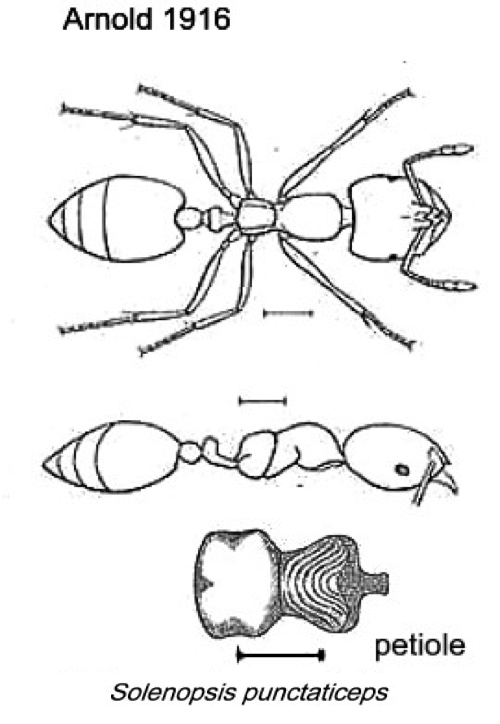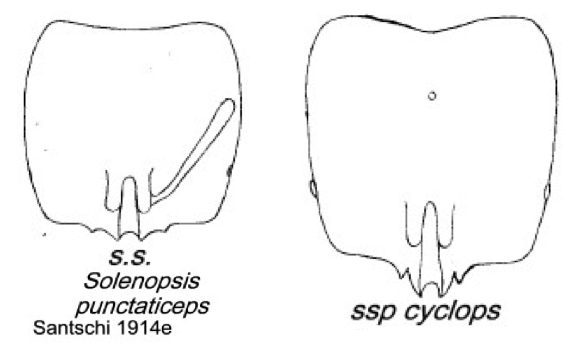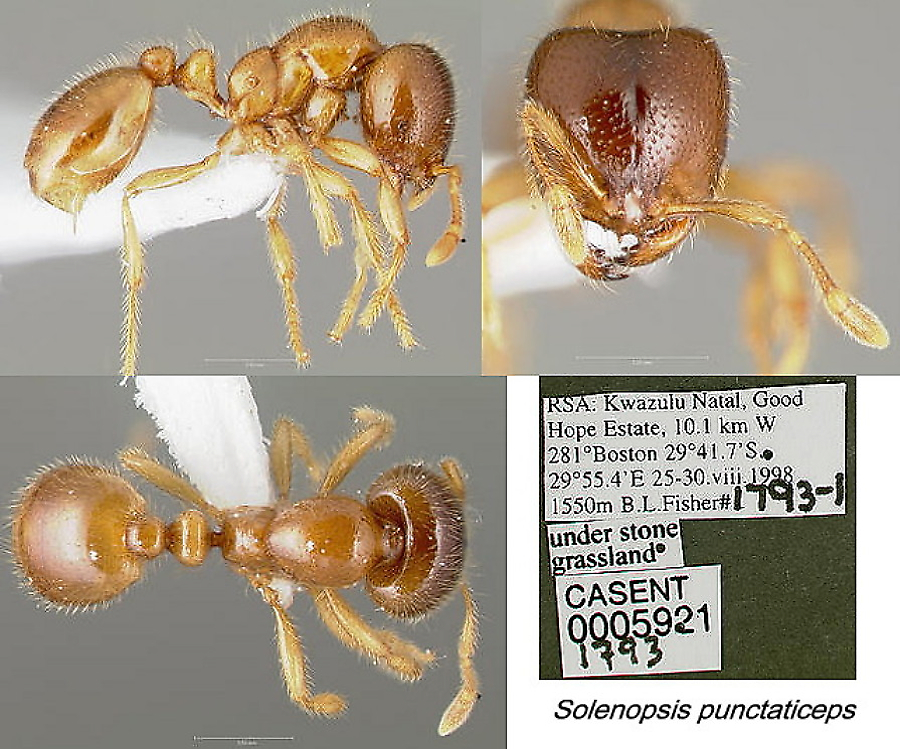Solenopsis punctaticeps Mayr
  Type location South
Africa (Solenopsis punctaticeps
nov. spec., Mayr, 1865: 109, worker; Forel, 1901e: 431, queen &
male) Table Mountain, Cape of Good Hope - see below Type location South
Africa (Solenopsis punctaticeps
nov. spec., Mayr, 1865: 109, worker; Forel, 1901e: 431, queen &
male) Table Mountain, Cape of Good Hope - see below
subspecies
caffra (Solenopsis
punctaticeps Mayr v. caffra
n. var., Forel, 1894b: 99, worker &
queen) from South Africa - see
http://www.antweb.org/specimenImages.do?code=casent0908871
junior synonyms
cyclops Solenopsis
punctaticeps Mayr stirps cyclops n. st., Santschi,
1914e: 19,
illustrated, major & minor workers) from South Africa - no images on Antweb
(October 2014)
and diversipilosa (Solenopsis punctaticeps
var. diversipilosa
nov. var., Mayr,
1901b: 15, worker) from South Africa - no images on Antweb
(October 2014)
cleptomana (Solenopsis
cleptomana n. sp., Santschi, 1914b: 80, worker) from Kenya,
Naivasha, xii.1911, Alluaud & Jeannel - see http://www.antweb.org/specimenImages.do?code=casent0913921
erythraea (Solenopsis
punctaticeps Mayr subsp. eryhtraea
n., Emery,
1915c: 64, illustrated, worker) from Eritrea, Asmara, Nefasit
(not Ethiopia as
given in Bolton, 1995) - see http://www.antweb.org/specimen.do?name=casent0904644
fur (Solenopsis
punctaticeps Mayr stirps fur
n. st., Santschi, 1926b: 230, worker, queen & male) from Zimbabwe
- see below
indocilis (Santschi, 1914d: 355, worker &
queen) from Guinea, Mamou, by F. Silvestri - see http://www.antweb.org/specimenImages.do?code=casent0913924
juba (Solenopsis
punctaticeps Mayr juba
subsp. nov., Weber, 1943c: 362, illustrated, worker & queen) from South
Sudan - no images on Antweb
(October 2014)
kibaliensis (Wheeler,
1922: 164, worker & male) from Zaïre - see http://www.antweb.org/specimenImages.do?code=casent0913925
all forms known (see
Bolton, 1995)  . .
|
 Mayr's
(1865) description is at Mayr's
(1865) description is at  . Forel's (1894b)
description of caffra
is at . Forel's (1894b)
description of caffra
is at  . Mayr's (1901b)
description of diversipilosa is at . Mayr's (1901b)
description of diversipilosa is at  . Forel's (1901e) description of the queen
and male is at . Forel's (1901e) description of the queen
and male is at  . Arnold (1916: 243) gave
an illustrated translation, this is at . Arnold (1916: 243) gave
an illustrated translation, this is at  and and  . Santschi's (1914b) description of cleptomana
is at . Santschi's (1914b) description of cleptomana
is at  . Santschi's (1914e)
illustrated description of cyclops is at . Santschi's (1914e)
illustrated description of cyclops is at  . Emery's (1915g) illustrated description
of erythraea is at . Emery's (1915g) illustrated description
of erythraea is at  . Emery (1915c) considered the various
varieties then known, with illustrations; this is on :- . Emery (1915c) considered the various
varieties then known, with illustrations; this is on :-  , ,  , ,  and and  . Santschi's (1926b) description of fur
is at . Santschi's (1926b) description of fur
is at  . Weber's (1943c)
description of juba is at . Weber's (1943c)
description of juba is at  . .
|
 Santschi
(1935) noted a single worker from Kindu, Zaïre, collected by Dr
Gerard. Earlier (1914d) he noted indocilis as TL 1.8-3.0; head
and thorax reddish-yellow, remainder yellow. Pilosity quite regular,
slightly shorter on the tibiae; head squarer; petiole a little wider at
the base and with a shorter pedicel, summit narrower; 7 workers, 5
queens. Santschi
(1935) noted a single worker from Kindu, Zaïre, collected by Dr
Gerard. Earlier (1914d) he noted indocilis as TL 1.8-3.0; head
and thorax reddish-yellow, remainder yellow. Pilosity quite regular,
slightly shorter on the tibiae; head squarer; petiole a little wider at
the base and with a shorter pedicel, summit narrower; 7 workers, 5
queens.
Wheeler (1922) described kibaliensis as living
in small craters in the soil and seen feeding on dead insects. The
species appears to have rectangular heads, with straight sides, rather
longer than broad in the smallest individuals, workers TL 2-2.8 mm. His
description follows -
WORKER - Length 2 to 2.8 mm. Apparently less polymorphic
than the typical punctaticeps and the subspecies caffra
Forel and therefore more like the subspecies erythraea Emery.
Head in all the individuals rectangular, with straight sides, as broad
in front as behind, not longer than broad in the largest, distinctly
longer in the smallest individuals. Median teeth of the clypeus long
and slender, lateral teeth obsolete or indicated only by feeble
projections. Petiolar node broader than the petiole, its upper border
straight and transverse. Sculpture much as in typical punctaticeps
and the hairs almost as abundant as in that form, but much shorter and
less erect, especially on the head. Color yellowish brown, legs and
antennae yellow; mandibular teeth dark brown. Small workers scarcely
paler.
MALE - Length 4.3 mm. (Typical form, black, TL 5 mm] Head with very
large eyes and ocelli, the latter extremely prominent; without the
mandibles broader than long. Mandibles with 3 denticles. Antennal
scapes nearly as long as the first two funicular joints together.
Thorax broadly elliptical, slightly flattened above, only slightly
longer than broad, much broader than the head. Propodeum bluntly
subangular in profile, the base distinctly longer than the declivity.
Nodes of petiole very low, rounded. Wings rather long; legs very
slender. Smooth and shining; head subopaque and finely longitudinally
striate behind. Hairs sparser and more reclinate than in the worker.
Brown; head black around the ocelli; mandibles, antennae and legs
yellowish. Wings rather opaque brownish hyaline, with very distinct
brown veins and pterostigma.
Described from twenty workers and a single male from Vankerckhovenville
(Lang & Chapin), on the Kibali River or Upper Uele. The specimens
were living in small craters in the soil and were seen feeding on dead
insects.
|
 The photomontage of
a syntype worker is collated from http://www.antweb.org/specimen.do?name=casent0902359 The photomontage of
a syntype worker is collated from http://www.antweb.org/specimen.do?name=casent0902359
|
 The photomontage of the type major worker of fur is collated from http://www.antweb.org/specimen.do?name=casent0902359 The photomontage of the type major worker of fur is collated from http://www.antweb.org/specimen.do?name=casent0902359
|
 The
photomontage is collated from http://www.antweb.org/specimen.do?name=casent0005921.
Locality: South Africa: Kwazulu Natal; Good Hope Estate, 10.1
km W 281° Boston; 29°41'42"S 029°55'24"E 1550m The
photomontage is collated from http://www.antweb.org/specimen.do?name=casent0005921.
Locality: South Africa: Kwazulu Natal; Good Hope Estate, 10.1
km W 281° Boston; 29°41'42"S 029°55'24"E 1550m
Collection Information: Collection codes: BLF1793 Date: 25-30 Aug 1998
Collected by: B.L.Fisher Method: ES11 under stone
Habitat: grassland
|
|